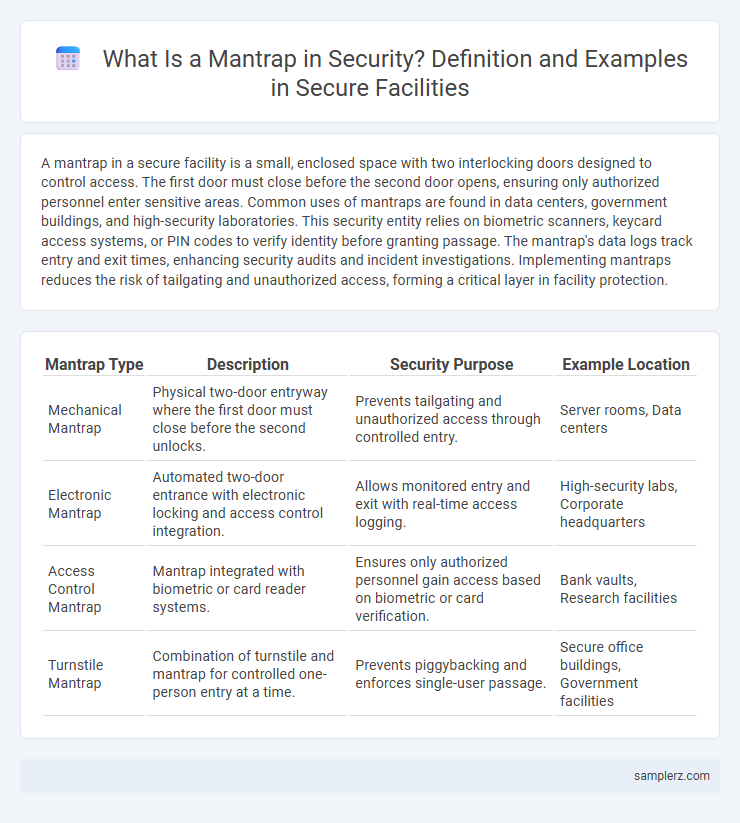A mantrap in a secure facility is a small, enclosed space with two interlocking doors designed to control access. The first door must close before the second door opens, ensuring only authorized personnel enter sensitive areas. Common uses of mantraps are found in data centers, government buildings, and high-security laboratories. This security entity relies on biometric scanners, keycard access systems, or PIN codes to verify identity before granting passage. The mantrap's data logs track entry and exit times, enhancing security audits and incident investigations. Implementing mantraps reduces the risk of tailgating and unauthorized access, forming a critical layer in facility protection.
Table of Comparison
| Mantrap Type | Description | Security Purpose | Example Location |
|---|---|---|---|
| Mechanical Mantrap | Physical two-door entryway where the first door must close before the second unlocks. | Prevents tailgating and unauthorized access through controlled entry. | Server rooms, Data centers |
| Electronic Mantrap | Automated two-door entrance with electronic locking and access control integration. | Allows monitored entry and exit with real-time access logging. | High-security labs, Corporate headquarters |
| Access Control Mantrap | Mantrap integrated with biometric or card reader systems. | Ensures only authorized personnel gain access based on biometric or card verification. | Bank vaults, Research facilities |
| Turnstile Mantrap | Combination of turnstile and mantrap for controlled one-person entry at a time. | Prevents piggybacking and enforces single-user passage. | Secure office buildings, Government facilities |
Introduction to Mantraps in Secure Facilities
Mantraps are physical security access control systems designed to prevent unauthorized entry by allowing only one person to pass through at a time using a set of interlocking doors. These secure vestibules employ biometric scanners, card readers, or PIN pads to verify identity between entry points, reducing tailgating and forced entry risks. Commonly installed at sensitive area entrances like data centers or research labs, mantraps enhance protection against infiltration and help maintain strict control over access.
Key Functions of Mantrap Systems
Mantrap systems in secure facilities function primarily to control and restrict unauthorized access by allowing only one person to enter at a time, ensuring identity verification through biometric scanners or access card readers. These systems create a physical buffer zone that isolates individuals until their credentials are validated, preventing tailgating and piggybacking. Integrated sensors and surveillance cameras enhance monitoring, while automatic locking mechanisms maintain secure containment within the mantrap until access is granted.
Typical Locations for Mantraps in Secure Environments
Mantraps are commonly installed at critical access points such as data centers, server rooms, and high-security laboratories to control and monitor personnel entry. These secure environments utilize mantraps to prevent unauthorized access, ensuring that only one individual can enter at a time, often requiring dual authentication methods. Typical locations also include vaults and restricted areas within financial institutions and government facilities, where stringent access control is paramount.
Physical Design Elements of Mantraps
Mantraps in secure facilities incorporate physical design elements such as reinforced steel doors, biometric access controls, and interlocking mechanisms to prevent tailgating and unauthorized entry. Transparent walls made of bullet-resistant glass enable visual verification without compromising security. Integrated alarm systems linked to each chamber ensure immediate response in case of forced entry attempts.
Mantrap Access Control Technologies
Mantrap access control technologies employ dual-door entry systems that prevent tailgating and unauthorized access by ensuring one door remains locked until the first door is securely closed. These systems integrate biometric scanners, RFID card readers, and turnstiles to authenticate individuals before granting entry to sensitive areas within secure facilities. Advanced mantraps can also include anti-passback features and real-time monitoring to enhance security and control the flow of personnel efficiently.
Real-World Examples of Mantrap Installations
Mantraps are commonly installed in high-security data centers, such as those operated by Google and Microsoft, to prevent unauthorized tailgating. Financial institutions like JPMorgan Chase use mantraps at their vault entrances, combining biometric authentication with physical security to control access. Airports, including London Heathrow, deploy mantraps in restricted areas to enhance security by trapping individuals between two security doors.
Best Practices for Mantrap Deployment
Effective mantrap deployment involves installing two interlocking doors where the first door must close before the second opens, ensuring controlled access to sensitive areas. Integrating biometric authentication and real-time monitoring systems enhances security by verifying identity and detecting tailgating attempts. Regular testing and maintenance of mechanical and electronic components maintain the integrity and reliability of the mantrap system in secure facilities.
Common Security Threats Addressed by Mantraps
Mantraps effectively mitigate tailgating by ensuring only one individual accesses secure areas at a time, preventing unauthorized entry. They also address piggybacking risks, where intruders follow authorized personnel unnoticed, by creating a controlled buffer zone between two sets of doors. Furthermore, mantraps help reduce insider threats by incorporating biometric verification and surveillance, enhancing overall facility security.
Integrating Mantraps with Facility Security Systems
Integrating mantraps with facility security systems enhances access control by ensuring only authorized personnel pass through secure entry points. Advanced mantrap solutions synchronize with biometric scanners, card readers, and surveillance cameras, allowing real-time monitoring and automated lockdowns in case of unauthorized access attempts. This integration strengthens perimeter defense, reduces tailgating risks, and provides comprehensive audit trails for security compliance.
Regulatory Compliance and Mantrap Use Cases
Mantraps in secure facilities play a crucial role in regulatory compliance by ensuring controlled access and preventing tailgating, which aligns with standards like ISO 27001 and HIPAA. Common use cases include protecting data centers, pharmaceuticals, and government buildings where sensitive information or assets require strict access control. These systems often integrate biometric authentication and intrusion detection to meet legal requirements and enhance physical security protocols.

example of mantrap in secure facility Infographic
 samplerz.com
samplerz.com